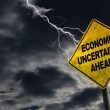Too Much of Everything
by Guy Haselmann, Director, Capital Markets Strategy, Scotiabank GBM
• Despite great emphasis on phraseology, some standard FOMC comments (and other routine discussion topics of the FOMC) have been repeated so often as to have lost meaning.
• Next week, the divided factions within the committee will decipher whether a voting majority is ‘reasonably confident that inflation will return to the desired rate over the medium term forecast horizon’. These familiar words constitute a major part of the Fed’s policy discussion. Embedded in this squabble is the belief that 2% inflation is the most preferred outcome, and maintaining interest rates at the zero lower bound is the most appropriate method for getting there. At best, these are suspect assumptions.
• Monetary stimulus works differently at the Zero Lower Bound. This is particularly true when most other central banks followed the Fed down to excessively low rates for fear of risking a stronger currency making them too uncompetitive.
• Free money has not led to inflation, but rather has fueled a deflationary spiral of the Fed’s own making. This is because low global interest rates have provided fertile ground for over-capacity and over-production. There is simply too much of everything - which is acting to keep prices lower. Simply stated, the Fed’s zero interest rate policy (ZIRP) is counter-productive towards its dual mandates. No doubt the FOMC believes otherwise.
• The FOMC appears myopically-focused on trying to stabilize short-term output and inflation, while disregarding the more costly longer-term risks associated with boom-bust cycles. I have written several notes about this “time inconsistency”. Accommodative rates, for example, have not had the desired or expected results on growth and inflation, but rather, low rates have created massive credit bubbles and asset price inflation.
• For the first time in history, corporate debt issuance exceeded $1 trillion in a calendar year in 2012. Every year since has surpassed the prior year. Issuance in 2015 is on target to beat the 2014 record by over 35%. Exceeding $100 billion of issuance in any one month period used to be a very rare occurrence, yet this has happened the past 5 months in a row.
• The proceeds from the issuance have been used to buy back shares and increase dividends, or more importantly, to improve processes and efficiencies. These improvements lower business costs and expose redundancies, which in turn allow firms to lay off workers and cut prices. This is normal progress no doubt, but something turbo-charged when money is exceedingly cheap. Unfortunately, when share buybacks are combined with QE purchases, financial assets prices become even more disconnected to the economic reality that they are supposed to represent.
• Financial asset prices that are ‘discovered’ by market forces are always superior in the long-run to those determined and administered by micro-managing unelected policy officials.
• Are FOMC members certain that the benefits, and joy, of higher inflation outweigh the potential costs and risks to financial instability? Are FOMC members certain that those benefits offset the damage being done to pensions, insurance companies and fixed income savers? Are they certain that credit-fueled growth today is not at the expense of overly-mortgaging growth tomorrow?
• Technological advances and globalization have acted for years to keep prices suppressed. These are beneficial advancements and trends that the Fed cannot do anything about. Regrettably however, the Fed does not make a distinction between the differences of good deflation and bad deflation.
• The Fed’s policy of providing excessive accommodation until inflation moves higher - especially when the factors capping inflation (and risks to financial stability) are poorly understood – may turn out to be a reckless policy choice.
• From an inflation point of view, investors should not concern themselves with whether the Fed is ‘behind the curve’ or not. We are in an environment where you do not have to worry about inflation until you begin to actually start to see it. The more immediate trades will be to see how markets react to lift-off and to the Fed’s shrinking balance sheet (in 2016). I maintain my recommendation to own long-dated US Treasury Bonds a while longer; regardless of whether the Fed hikes rate in July, September, or December.
“So you think that money is the root of all evil. Have you ever asked what is the root of all money?” – Ayn Rand
Regards,
Guy
Guy Haselmann | Capital Markets Strategy
▬▬▬▬▬▬▬▬▬▬▬▬▬▬▬▬▬▬▬▬▬▬▬▬▬▬▬
Scotiabank | Global Banking and Markets
250 Vesey Street | New York, NY 10281
T-212.225.6686 | C-917-325-5816
guy.haselmann[at]scotiabank.com
Scotiabank is a business name used by The Bank of Nova Scotia
Read/Download the complete report below:














